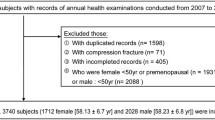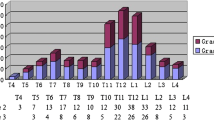Abstract
The aim of this study was to determine whether the probability of osteoporosis and osteopenia was affected by the risk factors, physical examination findings, or radiological investigations such as spinal X-rays in postmenopausal women. We assessed risk factors such as use of hormone replacement therapy, physical activity level, calcium intake, smoking, caffeine consumption, long-term immobilization, previous history of fracture, family history of fracture, presence of certain systemic diseases (hyperthyroidism or hyperparathyroidism), or use of medications (corticosteroids or others), physical examinations, and presence of vertebral fractures on spinal X-rays. Patients’ bone mineral density (BMD) was evaluated using dual energy X-ray absorptiometry (DXA) in the lumbar spine, and we compared the risk factors between osteopenic and osteoporotic women according to DXA. We evaluated 235 postmenopausal women who attended our osteoporosis outpatient clinic. Those patients were divided into two groups as either osteopenic (n=67, mean age: 63.1 years) or osteoporotic (n=168, mean age: 66.2 years) according to WHO criteria. The lumbar spinal (L1–L2) T-score values were −1.5±0.6 and −3.1±0.6 in osteopenic and osteoporotic groups, respectively. There were significant differences between the two groups in terms of mean age and lumbar BMD (p=0.009 and p<0.001, respectively). We also observed that vertebral tenderness on palpation, back pain, and existing vertebral fracture (fx) were significantly different between the osteopenic and osteoporotic groups (p<0.05). As a result of the statistical analysis, we found an equation to determine osteopenic and osteoporotic women by using those four factors (age, vertebral tenderness on palpation, back pain, and existing vertebral fx) in multivariate stepwise logistic regression. The equation is as follows: \(\hat Y\) (DXA) = −2.9024 + 0.044 (age in year) + 0.819 (vertebral fx) + 0.877 (pain) + 1.136 (vertebral tenderness). We can estimate whether a postmenopausal woman is osteopenic or osteoporotic based on these risk factors by using the stepwise logistic regression equation.

Similar content being viewed by others
References
Brown JP, Josse RG, Scientific Advisory Council of the Osteoporosis Society of Canada (2002) Clinical practice guidelines for the diagnosis and management of osteoporosis in Canada. CMAJ 12 [Suppl 10]:S1–S34
Genant HK, Cooper C, Poor G, Reid I, Ehrlich G, Kanis J, Nordin BE, Barrett-Connor E, Black D, Bonjour JP, Dawson-Hughes B, Delmas PD, Dequeker J, Ragi Eis S, Gennari C, Johnell O, Johnston CC Jr, Lau EM, Liberman UA, Lindsay R, Martin TJ, Masri B, Mautalen CA, Meunier PJ, Khaltaev N et al (1999) Interim report and recommendation of the World Health Organization Task-Force for Osteoporosis. Osteoporos Int 10:259–264
Weiss M, Ben-Shlomo AB, Hagag P, Rapoport M (2000) Reference database for bone speed of sound measurement by novel quantitative multi-site ultrasound device. Osteoporos Int 11:688–696
Tannirandorn P, Epstein S (2000) Drug-induced bone loss. Osteoporos Int 11:637–659
Rea JA, Li J, Blake GM, Steiger P, Genant HK, Fogelman I (2000) Visual assessment of vertebral deformities by X-ray absorptiometry: a highly predictive method to exclude vertebral deformity. Osteoporos Int 11:660–668
Kanis JA, Johnell O, Oden A, Sernbo I, Redlund-Johnell I, Dawson A, De Laet C, Jonsson B (2000) Long-term risk of osteoporotic fracture in Malmo. Osteoporos Int 11:669–674
Varenna M, Binelli L, Zucchi F, Ghiringhelli D, Gallazzi M, Sinigaglia L (1999) Prevalence of osteoporosis by educational level in a cohort of postmenopausal women. Osteoporos Int 9:236–241
Cummings SR, Palermo L, Browner W, Marcus R, Wallace R, Pearson J, Blackwell T, Eckert S, Black D (2000) Monitoring osteoporosis therapy with bone densitometry. Misleading changes and regression to the mean. JAMA 283:1318–1321
Michaelsson K, Bergsrom R, Mallmin H, Holmberg L, Wolk A, Ljunghall S (1996) Screening for osteopenia and osteoporosis: selection by body composition. Osteoporos Int 6:120–126
Stevenson JC (1998) Is there a case for targeting hormone replacement therapy for osteoporosis at the menopause? Osteoporos Int 8 [Suppl 1]:S47–S50
Tudor-Locke C, McColl RS (2000) Factors related to variation in premenopausal bone mineral status: a health promotion approach. Osteoporos Int 11:1–24
Wahner HW (1996) Use of densitometry in management of osteoporosis. In: Marcus R, Feldmen D, Kelsey J (eds) Osteoporosis. Academic Press, San Diego, CA, pp 1055–1072
Steiner E, Jergas M, Genant HK (1996) Radiology of osteoporosis. In: Marcus R, Feldmen D, Kelsey J (eds) Osteoporosis. Academic Press, San Diego, CA, pp 1019–1054
Broe KE, Hannan MT, Keily DK, Cali CM, Cupples LA, Keil DP (2000) Predicting fractures using bone mineral density: a prospective study of long-term care residents. Osteoporos Int 11:765–771
Kanis JA, Delmas P, Burckhardt P, Cooper C, Torgerson D (1997) Guidelines for diagnosis and management of osteoporosis. Osteoporos Int 7:390–406
Huuskonen J, Vaisanen SB, Kroger H, Jurvelin C, Bouchard C, Alhava E et al (2000) Determinants of bone mineral density in middle aged men: a population-based study. Osteoporos Int 11:702–702
Martinez Diaz-Guerra G, Hawkins F, Rapado A, Ruiz Diaz MA, Diaz-Curiel M (2001) Hormonal and anthropometric predictors of bone mass in healthy elderly men: major effect of sex hormone binding globulin, parathyroid hormone and body weight. Osteoporos Int 12:178–184
Christiansen C (1998) Practical application of risk assessment. Osteoporos Int 8 [Suppl 1]:S43–S46
Pressman A, Forsyth B, Ettinger B, Tosteson ANA (2001) Initiation of osteoporosis treatment after bone mineral density testing. Osteoporos Int 12:337–342
Author information
Authors and Affiliations
Corresponding author
Rights and permissions
About this article
Cite this article
Ofluoglu, D., Gunduz, O.H., Bekirolu, N. et al. A method for determining the grade of osteoporosis based on risk factors in postmenopausal women. Clin Rheumatol 24, 606–611 (2005). https://doi.org/10.1007/s10067-005-1110-0
Received:
Revised:
Accepted:
Published:
Issue Date:
DOI: https://doi.org/10.1007/s10067-005-1110-0




